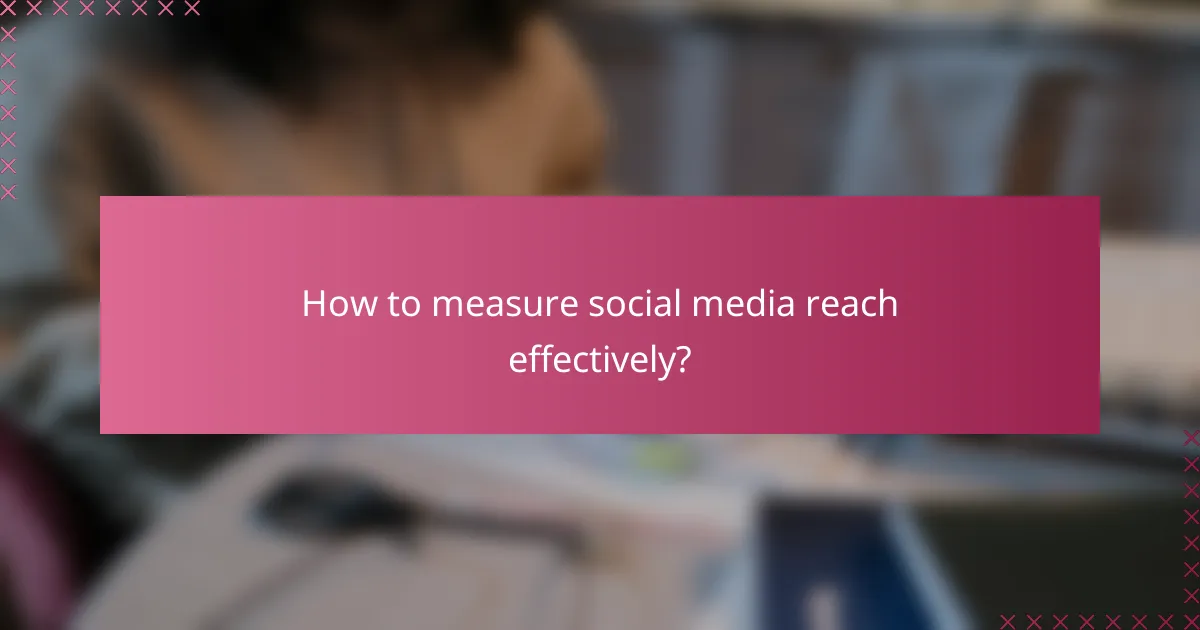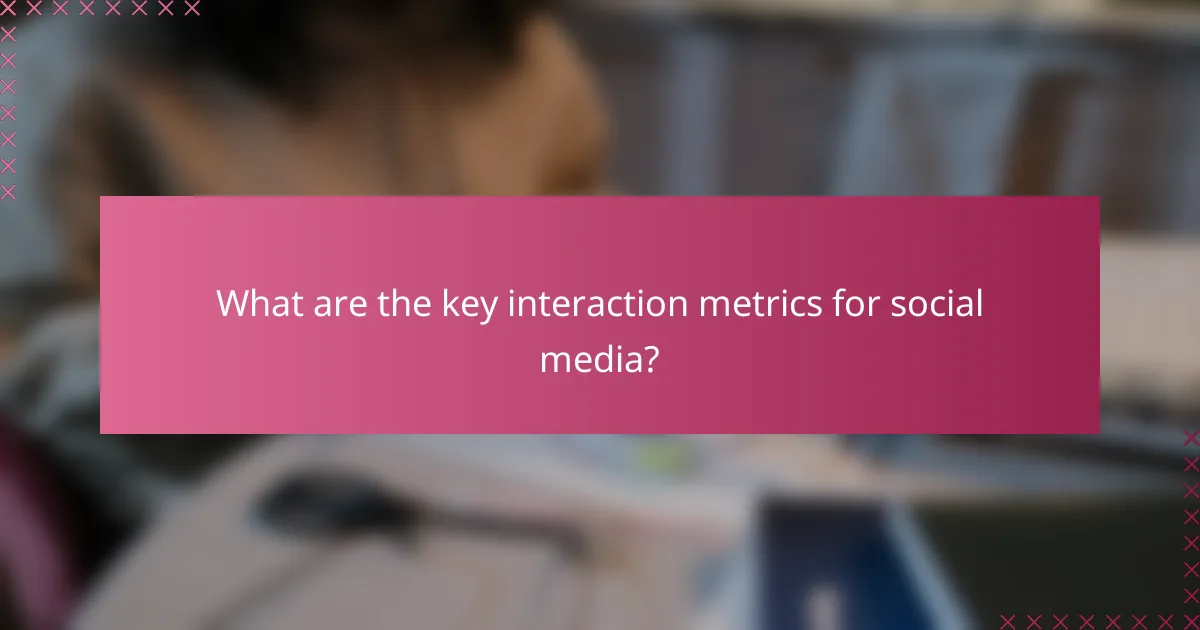Understanding social media engagement metrics is crucial for evaluating your brand’s online presence. Key metrics such as reach, interaction, and growth provide insights into how effectively your content is being seen, engaged with, and how your audience is expanding. By analyzing these metrics, you can refine your strategies to enhance visibility and foster deeper connections with your audience.

How to measure social media reach effectively?
Measuring social media reach effectively involves tracking how many unique users see your content across various platforms. This metric helps you understand the visibility of your posts and the potential audience size for your brand.
Use analytics tools like Facebook Insights
Facebook Insights provides valuable data on your posts’ performance, including reach and engagement metrics. Utilize this tool to analyze which types of content resonate most with your audience, allowing you to refine your strategy accordingly.
Other platforms, such as Instagram and Twitter, offer similar analytics tools. Regularly reviewing these insights can help you identify trends and adjust your content to maximize reach.
Track impressions and unique users
Impressions indicate how many times your content is displayed, while unique users show how many distinct individuals viewed it. A high number of impressions with a low count of unique users may suggest that your content is being shown repeatedly to the same audience.
Monitoring both metrics helps you gauge the effectiveness of your outreach efforts. Aim for a balance where impressions are high, but unique users are also growing, indicating a broader audience engagement.
Analyze audience demographics
Understanding the demographics of your audience is crucial for effective reach measurement. Tools like Google Analytics and platform-specific insights can provide data on age, gender, location, and interests.
This information allows you to tailor your content to better suit your audience’s preferences, potentially increasing engagement and expanding your reach. For example, if your audience skews younger, consider using platforms like TikTok or Snapchat for your campaigns.
Monitor referral traffic to e-commerce site
Tracking referral traffic from social media to your e-commerce site can provide insights into how well your social media reach translates into actual visits and conversions. Use UTM parameters in your links to accurately measure this traffic.
Regularly analyze this data to see which platforms drive the most traffic and sales. This can help you allocate resources effectively and focus on the channels that yield the best results for your business.

What are the key interaction metrics for social media?
The key interaction metrics for social media include engagement rate, comments, shares, and click-through rates. These metrics help assess how well content resonates with the audience and indicate overall performance on social platforms.
Engagement rate calculation
The engagement rate is a crucial metric that measures the level of interaction a post receives relative to its reach or impressions. It is typically calculated by dividing the total number of interactions (likes, comments, shares) by the total reach or impressions, then multiplying by 100 to get a percentage.
For example, if a post reaches 1,000 users and receives 50 interactions, the engagement rate would be 5%. A higher engagement rate often indicates that the content is resonating well with the audience, while a lower rate may suggest the need for adjustments in content strategy.
Comments and shares as indicators
Comments and shares are vital indicators of audience engagement and sentiment. Comments reflect direct feedback and can provide insights into audience opinions, while shares extend the reach of the content, indicating that users find it valuable enough to share with their networks.
Monitoring the number of comments and shares can help identify which types of content generate the most discussion and interest. Aim to create content that encourages conversation and sharing, as this can significantly enhance visibility and engagement.
Click-through rates on posts
Click-through rate (CTR) measures the effectiveness of a post in driving traffic to a specific link, such as a website or landing page. It is calculated by dividing the number of clicks by the number of impressions and multiplying by 100 to express it as a percentage.
A typical CTR for social media posts can vary widely, often ranging from 1% to 5%, depending on the platform and content type. To improve CTR, use compelling calls-to-action and ensure that links are relevant and enticing to your audience.

How to assess social media growth?
Assessing social media growth involves analyzing various metrics that indicate how well your audience is expanding and engaging with your content. Key metrics include follower growth rate, content performance, and comparisons with competitors to gauge your position in the market.
Follower growth rate analysis
Follower growth rate analysis measures how quickly your audience is increasing over a specific period. This metric is typically calculated by taking the number of new followers gained during a timeframe and dividing it by the total number of followers at the beginning of that period.
For example, if you start with 1,000 followers and gain 100 new followers in a month, your growth rate would be 10%. Regularly tracking this rate can help identify trends and the effectiveness of your marketing strategies.
Content performance over time
Evaluating content performance over time involves analyzing engagement metrics such as likes, shares, comments, and overall reach for your posts. This analysis helps determine which types of content resonate most with your audience and when they are most active.
For instance, if video posts consistently receive higher engagement than image posts, consider increasing your video content. Tools like Google Analytics or social media insights can provide valuable data to inform your content strategy.
Benchmarking against competitors
Benchmarking against competitors allows you to compare your social media metrics with those of similar brands in your industry. This process can reveal gaps in your strategy and highlight areas for improvement.
To conduct effective benchmarking, identify key competitors and analyze their follower growth, engagement rates, and content strategies. Tools like SEMrush or Sprout Social can assist in gathering this data, helping you set realistic goals and stay competitive in your market.
![]()
What tools can enhance social media metrics tracking?
Several tools can significantly improve the tracking of social media metrics, helping businesses understand their reach, interaction, and growth. Utilizing these tools allows for more informed decisions based on comprehensive data analysis.
Hootsuite for comprehensive analytics
Hootsuite offers a robust platform for tracking various social media metrics across multiple channels. It provides insights into post performance, audience engagement, and overall reach, allowing users to tailor their strategies effectively.
Key features include customizable dashboards and reporting tools that can help identify trends over time. Users can monitor interactions, follower growth, and engagement rates, making it easier to adjust content strategies based on real-time data.
Sprout Social for engagement insights
Sprout Social specializes in providing deep engagement insights, focusing on how audiences interact with content. Its tools help analyze comments, shares, and likes, offering a clearer picture of audience sentiment and preferences.
This platform also includes features for social listening, allowing brands to track mentions and conversations about their products or services. By understanding engagement patterns, businesses can enhance their communication strategies and foster stronger relationships with their audience.
Google Analytics for traffic tracking
Google Analytics is essential for tracking traffic generated from social media platforms to websites. It provides data on user behavior, conversion rates, and referral sources, helping businesses gauge the effectiveness of their social media campaigns.
By setting up goals and tracking events, users can measure how social media efforts contribute to overall website performance. This insight is crucial for optimizing content and improving return on investment (ROI) from social media marketing efforts.

What are the prerequisites for effective social media measurement?
Effective social media measurement requires a clear understanding of your objectives and the metrics that will help you gauge success. Establishing these prerequisites ensures that your efforts are targeted and measurable, leading to better engagement and growth.
Define clear goals and KPIs
Setting clear goals and key performance indicators (KPIs) is essential for measuring social media success. Goals should be specific, measurable, achievable, relevant, and time-bound (SMART). For example, aiming to increase engagement by 20% over the next quarter provides a clear target to work towards.
Common KPIs include reach, impressions, likes, shares, comments, and follower growth. Choose metrics that align with your goals; for instance, if your aim is brand awareness, focus on reach and impressions rather than just follower count.
Establish a consistent posting schedule
A consistent posting schedule helps maintain audience engagement and improves visibility on social media platforms. Regularly sharing content keeps your brand top-of-mind and encourages interaction. Aim for a frequency that suits your audience and platform; for instance, posting daily on Instagram may be effective, while LinkedIn might benefit from 2-3 posts per week.
Utilize social media management tools to plan and automate your posts. This ensures that you maintain consistency even during busy periods. Monitor engagement patterns to adjust your schedule based on when your audience is most active, maximizing the impact of your posts.
